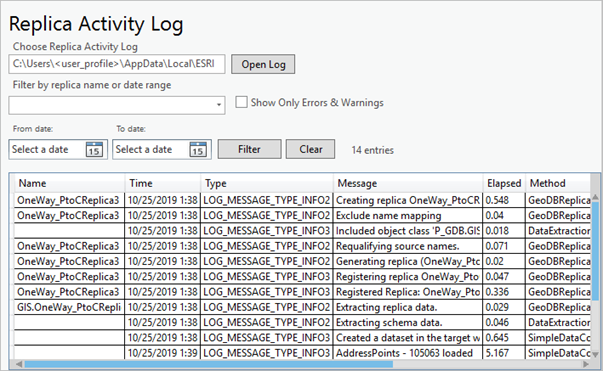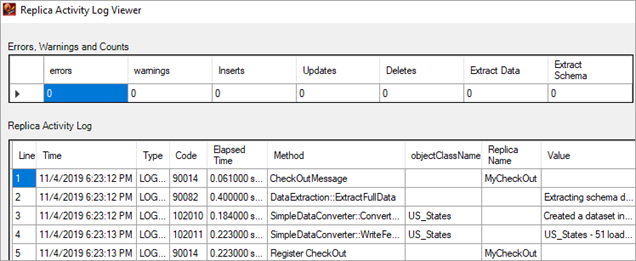HOW TO
Get a formatted view of the Replica Activity Log
Summary
When a replica creation or synchronization process is performed in ArcGIS, detailed information about the process is recorded in the replica activity log file. Custom Add-ins can be installed and applied to ArcMap and ArcGIS Pro clients to provide a formatted view of the replica activity log. This information can be used to troubleshoot errors and performance-related issues in replica creation or synchronization.
While the contents of the replica activity log file can be viewed directly in a text editor, optionally you can see a formatted view of the replica activity log using a custom add-in. Determining which custom add-in to access and install depends on the ArcGIS client used to create the replica or synchronize changes between a replica pair.
ArcGIS Pro Replica Log Viewer
Note: The ArcGIS Pro Replica Log Viewer add-in is available beginning with the ArcGIS Pro 2.5 client release. The ArcGIS Pro Replica Log Viewer, is a custom add-in and not supported by Esri Technical Support.
The ArcGIS Pro Replica Log Viewer provides a formatted view of the ArcGIS Pro replica activity log file (ProReplicaActivityLog.dat), plus additional options to filter the information displayed including:
- Open Log—Browse to the ArcGIS Pro Replica Activity Log file location
The default location for the ProReplicaActivityLog.dat file is located in:
C:\Users\<user_profile>\AppData\Local\ESRI\ProReplicaActivityLog.dat
- Filter by Replica Name—Filter based on replica names found in the log file
- Filter by Date Range—Filter replica activity log information using a range of dates
- Show Only Errors & Warnings—Only display errors and warnings captured in the replica activity log file

ArcMap Replica Log Viewer
Note: The ArcMap Replica Activity Log Viewer is available with ArcMap 10.5.1 and later ArcGIS Desktop client releases. This is a custom add-in and not supported by Esri Technical Support.
The ArcMap Replica Activity Log Viewer provides a formatted view of the ArcMap replica activity log file (ReplicaLog.dat) plus a summary of errors, warnings and edit counts, as shown below

In the image above, the activity log contains information about a single replica creation process. The top of the report indicates that there are 0 errors and 0 warnings within the log. The Method column of the table describes the operations that occurred during the replica creation process as follows:
- CheckOutMessage—A replica creation process was started for a replica named MyCheckOut at 6:23:12 PM.
- ExtractFullData—The first step was to extract the data and schema. Extraction involves creating a feature class on the target, then copying data from the source to the target. Additional entries would be generated in the log for each feature class and table in the replica.
- ConvertFeatureClass—In this example, only a single feature class, US_States, is being replicated. This row indicates that the feature class was created in the target at 6:23:12 PM.
- WriteFeatures—A total of 51 features were copied from the source to the target for the US_States feature class at 6:23:13PM. By comparing with the previous step, we can see that it took one second to copy the features.
- Register CheckOut—The last step was to register the replica on the source and target geodatabases. From the time completed, we can see that it took less than one second to register the replicas.
Procedure
ArcGIS Pro Replica Log Viewer Add-In
Complete the following steps to install and set up the ArcGIS Pro Replica Log Viewer, a custom ArcGIS Pro add-in that allows you to see a formatted view of the information within the ArcGIS Pro replica activity log file:
Install:
- Download the RAViewer.zip file
- Extract the RAViewer.esriAddinX file from the zip file, and place the file in a local directory.
- Before you install an add-in, it must be validated. To begin validation, locate the add-in within the local directory and double-click the RAViewer.esriAddinX file. When you double-click an add-in, the Esri ArcGIS Add-In Installation Utility opens automatically.
- Select Install Add-In.
- From ArcGIS Pro, open a project, click the Project tab on the ribbon and select Add-In Manager.
- Alternatively, on the ArcGIS Pro Start page, click Settings
 in the lower left corner and select Add-In Manager.
in the lower left corner and select Add-In Manager.
- Alternatively, on the ArcGIS Pro Start page, click Settings
- From the Add-In Manager, select Options and Add Folder. Browse to the location where the Add-In file is located. See Add-in Manager options for more information.
- From the Add-In Manager, select Add-Ins and the RAViewer should now be listed under My Add-Ins.
- Adding and removing add-ins requires an application restart to take effect. See Manage Add-ins for more information, or Troubleshooting if you encounter issues with the ArcGIS Pro add-in.
Setup:
- From your ArcGIS Pro project, select Add-In on the ribbon.
- Click the Open Replica Log button for the Replica Log Viewer to display.
ArcMap Replica Log Viewer Add-In
Complete the following steps to access and install the ArcMap Replica Log Viewer, a custom ArcMap add-in that allows you to see a formatted view of the information within the ArcMap replicalog.dat file:
Install:
- Download the ReplicaLogViewer.zip file.
- Extract the ReplicaLogViewer.esriAddIn file and place the file in a local directory.
- Double-click the ReplicaLogViewer.esriAddIn to install it.
- Open ArcMap and go to the Customize menu, Customize Mode, and click the Commands tab.
- Under Categories: scroll down, and click Replica Log Viewer.
- If you don't see Replica Log Viewer under Categories, scroll up and look under a category called Add-In Controls.
- Drag and drop the Replica Log Viewer on any existing toolbar (for example, the Distributed Geodatabase toolbar).
- Close the Customize dialog.
- If the Replica Log Viewer is not listed, then from the Customize menu, select Add-In Manager, and ensure the ReplicaLogViewer is listed under My Add-Ins. See Sharing and installing add-ins for more information about Esri ArcGIS Add-In Installation Utility.
Setup:
- In ArcMap, click the recently added Replica Log Viewer button.
- The Replica Activity Log Viewer opens, and choose either:
- Get Current Replica Log
If the replica activity log location has been set, the application will open up to that location. - Upload Replica Log
Open a .dat file from another location.
- Get Current Replica Log
Article ID: 000009984
- ArcMap
- ArcGIS Pro 2 x
Get help from ArcGIS experts
Start chatting now

